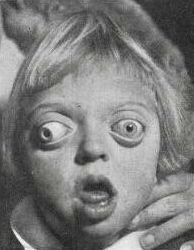Crouzon syndrome
| Crouzon syndrome | |
|---|---|
 |
|
| Patient with Crouzon syndrome (1912) | |
| Classification and external resources | |
| Specialty | medical genetics |
| ICD-10 | Q75.1 |
| ICD-9-CM | 756.0 |
| OMIM | 123500 |
| DiseasesDB | 3203 |
| eMedicine | ped/511 derm/734 |
| MeSH | D003394 |
Crouzon syndrome is an autosomal dominant genetic disorder known as a branchial arch syndrome. Specifically, this syndrome affects the first branchial (or pharyngeal) arch, which is the precursor of the maxilla and mandible. Since the branchial arches are important developmental features in a growing embryo, disturbances in their development create lasting and widespread effects.
This syndrome is named after Octave Crouzon, a French physician who first described this disorder. He noted the affected patients were a mother and her daughter, implying a genetic basis. First called "craniofacial dysostosis", the disorder was characterized by a number of clinical features. This syndrome is caused by a mutation in the fibroblast growth factor receptor II, located on chromosome 10.
Breaking down the name, "craniofacial" refers to the skull and face, and "dysostosis" refers to malformation of bone.
Now known as Crouzon syndrome, the characteristics can be described by the rudimentary meanings of its former name. What occurs is that an infant's skull and facial bones, while in development, fuse early or are unable to expand. Thus, normal bone growth cannot occur. Fusion of different sutures leads to different patterns of growth of the skull.
Examples include: trigonocephaly (fusion of the metopic suture), brachycephaly (fusion of the coronal suture), dolichocephaly (fusion of the sagittal suture), plagiocephaly (unilateral premature closure of lambdoid and coronal sutures), oxycephaly (fusion of coronal and lambdoidal sutures), Kleeblattschaedel (premature closure of all sutures).
...
Wikipedia
